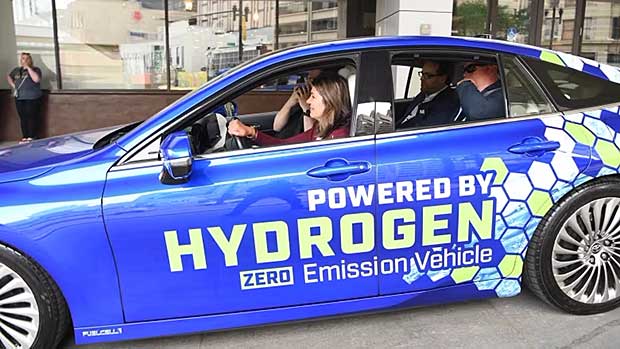The Alberta government is exploring the potential of hydrogen fuel cell cars in a world that has predominantly embraced electric plug-in cars.
Danielle Smith envisions a promising future for zero-emission vehicles, a type that’s currently not been used in Alberta.
Do you recall during the midst of Alberta’s Hot Donair Summer, when Premier Smith strolled alongside someone dressed in an attention-grabbing government surplus outfit at a food festival? She proudly traveled to the State of Edmonton in a vehicle powered by a hydrogen fuel cell electric system.
Following her experience, Smith commended, “They’re pretty zippy. They work pretty well.”
She not only believes in Alberta’s future adoption of hydrogen fuel cell cars, but also expressed her desire on the Your Province. Your Premier call-in show to make her next vehicle purchase one of these hydrogen-powered cars.
Indeed, there are close to 9,000 electric vehicles currently in use on Alberta’s roadways, along with hundreds of charging stations. With the impending 2035 ban on the sale of new petroleum-powered vehicles by Ottawa, Smith is inclined towards a distinct choice for achieving net-zero emissions.
Here’s what Smith said on the radio, “I think our solution for zero-emission vehicles is hydrogen — and they’re already here.”
Smith has translated her enthusiasm into tangible government initiatives, directing her Service Alberta minister to actively seek the establishment of a network of hydrogen refueling stations throughout the province. Currently, there are none available to the public.
Additionally, the province is initiating a comprehensive study to assess the feasibility of converting either the entire government fleet, consisting of 3,400 vehicles, or a portion of it to hydrogen power, including vehicles like sheriffs’ cruisers, Alberta Forestry, and Parks ranger trucks, to hydrogen power.
Smith, who’s a premier in a province that is located many thousands of kilometers away from anything resembling an automotive industry, had this to say, “Alberta might even try to woo Toyota or Hyundai to come to our province to build a car manufacturing plant.”
Smith isn’t the only one who shares this viewpoint. Numerous environmentally conscious advocates, business executives, and government representatives hold the belief that hydrogen fuel cell cars can play a crucial role in reducing carbon emissions in the transportation sector, in addition to plug-in battery electric vehicles. In fact, Jonathan Wilkinson, the federal natural resources minister, owns such a vehicle.
I’m a Believer Says Alberta’s Premier
Smith adopts a techno-optimistic stance regarding a type of zero-emissions vehicle that is still in experimental phases within Alberta, but she expresses pessimism towards plug-in electric vehicles (EVs), which are the dominant zero-emission choice in North America. The economic dynamics of natural gas in Alberta could serve as a driving factor behind this perspective.
Her contrast in outlook, marked by optimism and pessimism, is evident in her skepticism toward the dependability and feasibility of the most widely embraced sources of emission-free power generation, namely wind and solar power. Conversely, she exhibits enthusiasm for exploring emerging technologies such as small modular nuclear reactors and electricity generated from hydrogen.
Her contrast in outlook, marked by optimism and pessimism, is evident in her skepticism toward the dependability and feasibility of the most widely embraced sources of clean energy generation, namely wind and solar power. Conversely, she exhibits enthusiasm for exploring emerging technologies such as small modular nuclear reactors and electricity generated from hydrogen.
These approaches have become Smith’s way of expressing optimism about achieving net-zero emissions while simultaneously raising questions about what many others consider the primary catalysts for decarbonization. Depending on your perspective, Smith has either taken a different lane or opted for an entirely distinct direction.
Citation
